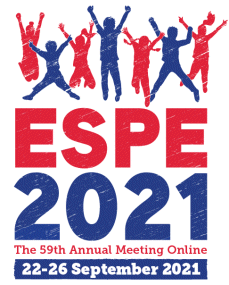
59th Annual ESPE (ESPE 2021 Online)
Online,
22 Sep 2021 - 26 Sep 2021

ePoster Category 2
Thyroid
hrp0094p2-446 | Thyroid | ESPE2021
The efficacy and short- and long-term side effects of radioactive iodine treatment in pediatric Graves’ disease: a systematic review
Lutterman Sarah , Zwaveling-Soonawala Nitash , Verberne Hein , Verburg Frederik , van Trotsenburg Paul , Mooij Christiaan
hrp0094p2-447 | Thyroid | ESPE2021
Incidentally detected papillary thyroid cancer with elevated calcitonin in a 15 year-old female: A case report
Yang Jaejin , Lee Wonae , Yu Jeesuk
hrp0094p2-448 | Thyroid | ESPE2021
Methimazole-induced remission rates in pediatric graves’ disease: A systematic review
van Lieshout Jelmer , Mooij Christiaan , van Trotsenburg Paul , Zwaveling-Soonawala Nitash
hrp0094p2-449 | Thyroid | ESPE2021
Congenital multinodular goiter causing acute airway obstruction in a newborn: a case report
Mirjam Scheffer-Rath , Katharina Löhner , Nitash Zwaveling-Soonawala , Boot Annemieke
hrp0094p2-450 | Thyroid | ESPE2021
Initial response to thionamide medication in young people with newly diagnosed thyrotoxicosis
Wood Claire , Morrison Niamh , Cole Michael , Donaldson Malcolm , Dunger David , Wood Ruth , Pearce Simon , Cheetham Tim
hrp0094p2-451 | Thyroid | ESPE2021
A girl with Trisomy 21 presents with Van Wyk-Grumbach syndrome. A rare diagnosis
Dikaiakou Eirini , Vlachopapadopoulou Elpis Athina , Kosteria Ioanna , Panos Alexandros , Dede Eirini , Koutrouveli Eleni , Zouridaki Christina , Michalacos Stefanos
hrp0094p2-452 | Thyroid | ESPE2021
Complications after pediatric thyroidectomy: lymph node dissection is a risk factor for permanent hypocalcemia
van Rooijen Jesse J. , Paul van Trotsenburg A.S. , Zwaveling-Soonawala Nitash , Nieveen van Dijkum Els J.M. , Engelsman Anton F. , Derikx Joep P.M. , Mooij Christiaan F.
hrp0094p2-453 | Thyroid | ESPE2021
Kinetics of FT4 serum concentrations in newborns and infants with congenital hypothyroidism during follow-up differ in the three severity groups
Steffens Britta , Gächter Pascal , Koch Gilbert , l'Allemand Dagmar , Janner Marco , Konrad Daniel , Welzel Tatjana , Pfister Marc , Szinnai Gabor
hrp0094p2-454 | Thyroid | ESPE2021
Thyroid dysfunction in small for gestational age infants: a need for second screening?
hrp0094p2-455 | Thyroid | ESPE2021
Expression of Zinc transporter 8 in thyroid tissues from patient with immune and non-immune thyroid diseases
Bossowski Artur , Niklinska Wiesława , Gasowska Marta , Polnik Dariusz , Szalecki Mieczysław , Mikłosz Agnieszka , Chabowski Adrian , Reszec Joanna
hrp0094p2-456 | Thyroid | ESPE2021
Hashimoto Thyroiditis: long term follow-up from childhood to young adulthood
David Francesco , Casula Letizia , Guzzetti Chiara , Ibba Anastasia , Loche Sandro
hrp0094p2-457 | Thyroid | ESPE2021
A case of complete atrioventricular block after initiation of methimazole in a patient with Graves' disease associated with Down's syndrome previously undergoing cardiac surgery
Sawano Kentaro , Hiroshima Shota , Shibata Nao , Nyuzuki Hiromi , Ogawa Yohei , Nagasaki Keisuke
hrp0094p2-458 | Thyroid | ESPE2021
Unilateral autoimmune ophthalmopathy as a first symptom in manifestation of autoimmune thyroiditis and systemic lupus erythematosus in an adolescent girl. Case report.
hrp0094p2-459 | Thyroid | ESPE2021
Incidence and etiology of primary congenital hypothyroidism in Flanders
Ryckx Sofie , De Mey Lynn , Marcelis Lionel , Vanbesien Jesse , Gies Inge , Staels Willem , Regal Luc , De Schepper Jean
hrp0094p2-460 | Thyroid | ESPE2021
Re-evaluation of the prevalence of permanent congenital hypothyroidism in Niigata, Japan: A retrospective study
Nagasaki Keisuke , Nyuzuki Hiromi , Shibata Nao , Sawano Kentaro , Hiroshima Shota , Ogawa Yohei
hrp0094p2-461 | Thyroid | ESPE2021
Early reassessment in congenital hypothyroidism
Grau Gema , Bertholt María Laura , Chueca María , Artola Elena , Fernández María Concepción , Sarasua Ainhoa , Rodríguez Amaia , Vela Amaia , Berrade Sara , Naranjo Cristina , Puges Laura , Diez Ignacio , Espada Mercedes , Ascunce Nieves , Porras Begoña , Rica Itxaso
hrp0094p2-462 | Thyroid | ESPE2021
Growth impairment in children with severe autoimmune primary hypothyroidism and pituitary hyperplasia without goiter
Corica Domenico , Kucharska Anna Malgorzata , Vierucci Francesco , Valenzise Mariella , Li Pomi Alessandra , Tuli Gerdi , Munarin Jessica , Pyrzak Beata , Cesaretti Graziano , Aversa Tommaso , Wasniewska Malgorzata
hrp0094p2-463 | Thyroid | ESPE2021
The use of intravenous introduction of glucocorticoids in the active stage of graves’ ophthalmopathy in childhood. Clinical Case
Ivannikova Tatiana , Nagaeva Elena , Bezlepkina Olga
hrp0094p2-464 | Thyroid | ESPE2021
Atypical presentation of acute suppurative thyroiditis in a 6 year old child.
Liapi Maria , Möllers Martin , Feldkamp Joachim , Jorch Norbert
hrp0094p2-465 | Thyroid | ESPE2021
Allan-Herndon-Dudley syndrome: case report of a rare disorder
Navasardyan Lusine , Muradyan Irina
hrp0094p2-468 | Thyroid | ESPE2021
Thyroid function in preterm infants admitted to the neonatal intensive care unit: a single center study
Nicolas Georges , Achkar Joy , Akiki Simon
hrp0094p2-469 | Thyroid | ESPE2021
Thyroid dysfunction in Beta-thalassemia patients
Mustapha Noumi , Ladj MS , Rachid Terrak , Aissat L , Boukari R
hrp0094p2-470 | Thyroid | ESPE2021
Victim pathologies of the pandemic. Severe acquired hypothyroidism
Diez-Lopez Ignacio , Mesonerp Sara , Madera Maria , Sarasua-Miranda Ainhoa
hrp0094p2-471 | Thyroid | ESPE2021
Mitigating thyroid cancer risk in multinodular hyperplasia secondary to a 10q23.31 deletion (PTEN Hamartoma Tumour Syndrome)
hrp0094p2-472 | Thyroid | ESPE2021
Thyroid dysfunction and autoimmune thyroiditis in children with new-onset diabetes mellitus
Kim Goo Lyeon , Chun Sangwoo , Yu Jeesuk
hrp0094p2-473 | Thyroid | ESPE2021
A rare cause of congenital hypothyroidism: Brain-lung-thyroid syndrome
Yilmaz Aslihan Arasli , Erdeve Senay Savas , Yuksel Deniz , Oztoprak Ulkuhan , Cetinkaya Semra
hrp0094p2-474 | Thyroid | ESPE2021
Recurrent fractures in a child with Graves' disease
Kilci Fatih , Jones Jeremy , Çizmecioğlu Jones Filiz Mine
hrp0094p2-475 | Thyroid | ESPE2021
Case study of 13- year-old boy suffering from papillary thyroid cancer in stage pT3aN1bMX
Bossowski Artur , Borysewicz-Sanczyk Hanna , Stożek Karolina , Dzięcioł Janusz , Czarniecka Agnieszka , Handkiewicz-Junak Daria , Jarząb Barbara
hrp0094p2-476 | Thyroid | ESPE2021
Evaluation of general characteristics of children with hypothyroidism
Bulut Eman , Eklioglu Beray Selver , Atabek Mehmet Emre
hrp0094p2-477 | Thyroid | ESPE2021
L-T4 absorption test in 14-year-old patient with severe refractory hypothyroidism after total thyroidectomy
Vincenzi Gaia , Di Stefano Marina , Abbate Marco , Tarantola Giulia , Barera Graziano , Vigone Maria Cristina
hrp0094p2-478 | Thyroid | ESPE2021
A child with anti-thyroid arthritis syndrome
Kilci Fatih , Sönmez Hafize Emine , Jones Jeremy , Közler Selen Hürmüzlü , Çizmecioğlu Jones Filiz Mine
hrp0094p2-479 | Thyroid | ESPE2021
Thyroglobulin deficiency: a rare cause of neonatal stridor
Tseretopoulou Xanthippi , Reddy Nithya , Pinnamaneni RagaMallika , Jonas Nicolaas , Schoenmakers Nadia , Walton-Betancourth Sandra
hrp0094p2-480 | Thyroid | ESPE2021
TBG deficiency and Central Congenital Hypothyroidism (CCH): Our experience in neonatal screening with TSH and T4
Chueca Maria J. , Grau Gema , Bertholt Laura , Artola Elena , Fernández Concepción , Sarasua Ainhoa , Rodriguez Amaia , Vela Amaia , Belza Amaia , Berrade Sara , Dura Teodoro , Alonso Pablo , Puges Laura , Diez Ignacio , Espada Mercedes , Ederra Maria , Ascunce Nieves , Porras Begoña , Rica Itxaso
hrp0094p2-481 | Thyroid | ESPE2021
A case of hypothyroidism post bone marrow transplantation
Baz Ouidad , Chelghoum Imane Lydia , Mimouni Safia
hrp0094p2-482 | Thyroid | ESPE2021
Iodine status and autoimmune thyroiditis in children; a case-control study in Sri Lanka
Hashim Raihana , Mahesh Buddika , Atapattu Navoda , de Silva Shamya
hrp0094p2-483 | Thyroid | ESPE2021
A 9-year-old girl with Van Wyk and Grumbach syndrome: precocious puberty as a rare consequence of hypothyroidism
hrp0094p2-484 | Thyroid | ESPE2021
Iodine Deficiency Cretinism in Tuva Republic
hrp0094p2-485 | Thyroid | ESPE2021
Prevalence and associated factors of Congenital Hypothyroidism in Bogotá, Colombia. 2014 - 2020
Pineda Pablo , Beltrán Daniela , Salazar Alexander , Sarmiento Karen , Zarante Ignacio , Urueña Ana
hrp0094p2-486 | Thyroid | ESPE2021
Aetiology and different clinical condition of hypothyroidism in children and adolescents
hrp0094p2-487 | Thyroid | ESPE2021
Influenza A induced Thyrotoxic Storm Post Haematopoietic Stem Cell Transplantation
Bhayankaram Nuthana Prathivadi , Murray Philip
hrp0094p2-488 | Thyroid | ESPE2021
The state of iodine deficiency in Krasnoyarsk territory according to results of neonatal TSH screening in 2019
hrp0094p2-489 | Thyroid | ESPE2021
Thyrotropic cell hyperplasia secondary to prolonged uncontrolled primary hypothyroidism
Ariza Jimenez Ana Belen , Ariza Jimenez Jose Antonio , Vargas Elena Lopez
hrp0094p2-490 | Thyroid | ESPE2021
Thyroid dyshormonogenesis: a case report of two siblings with a heterozygous variant in the TPO gene.
Vadina Tatiana , Konushova Marina , Eremyan Aikaz , Shreder Ekaterina , Nagaeva Elena , Zaharova Svetlana , Degtyarev Michael , Bezlepkina Olga
hrp0094p2-491 | Thyroid | ESPE2021
Pediatric Graves’ disease in southern Tunisia
Kmiha Sana , Zghal Mohammed Ali , Chabchoub Imen , Ameur Salma Ben , Aloulou Hajer , Kammoun Thouraya



